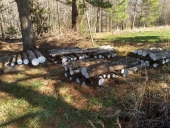




'Theoretically this level of creeping Orwellian dynamics should ramp up our awareness, but what happens instead is that each alert becomes less and less effective because we're incredibly stupid.' - Jerry Holkins
 2
2




Please give me your thoughts on my Affordable, double-paned earthbag window concept





















Rob Lineberger wrote:Maybe no one has snatched up the resource because it's not something people would think to do. If you'd asked me "what's a good soil amendment?" I don't think net scrapings would have ever made the list. Good for you thinking laterally.
It is hard to visualize this but I see four potential problems:
1) copper
IMO the way to check for that is ask for a crate or two of the sludge, then do a test area and plant plants. If a plant gets too much copper, it dies. I'd select an area you don't care about particularly much.
2) salt
IMO the way to check for that is ask for a crate or two of the sludge, then do a test area and plant plants. If a plant gets too much salt, it dies. :)
3) calcium
In aquaculture, shells are a way to alter the pH and calcium carbonate (hardness) levels of the water. It's kinda hard to alter the pH of soil, but dumping a ton of seashells on it seems like a good way. I'd do a thorough pH and hardness test on your test area, then again right after dumping the scrapings, then again a few weeks later.
4) impermeability
If you do indeed get a solid layer of algae-covered shells, I could see that leading to issues. You could get around this by screening the sludge, but screening 25 tons seems like a chore.
Now the benefits are cost, availability, and nutrients you wouldn't easily get otherwise. Is that worth the effort and risk? I don't know. It's a cool idea.
'Theoretically this level of creeping Orwellian dynamics should ramp up our awareness, but what happens instead is that each alert becomes less and less effective because we're incredibly stupid.' - Jerry Holkins





|
I knew I would regret that burrito. But this tiny ad has never caused regrets:
Freaky Cheap Heat - 2 hour movie - HD streaming
https://permies.com/wiki/238453/Freaky-Cheap-Heat-hour-movie
|



